Leadership & Management: ASDA Operations, Roles, and Theories
VerifiedAdded on 2023/01/09
|9
|2513
|49
Report
AI Summary
This report provides a comprehensive analysis of leadership and management in business operations, focusing on the roles and characteristics of leaders and managers within the context of ASDA, a large supermarket retailer. It differentiates between the roles of a leader and the functions of a manager, illustrating their application in various situational contexts such as implementing changes and resolving conflicts. The report also explores the application of different leadership theories and models, including situational leadership, systems leadership, and contingency theory, to address operational challenges and improve organizational performance. By examining these concepts in relation to ASDA's operations, the report offers insights into how effective leadership and management practices contribute to organizational productivity and profitability.
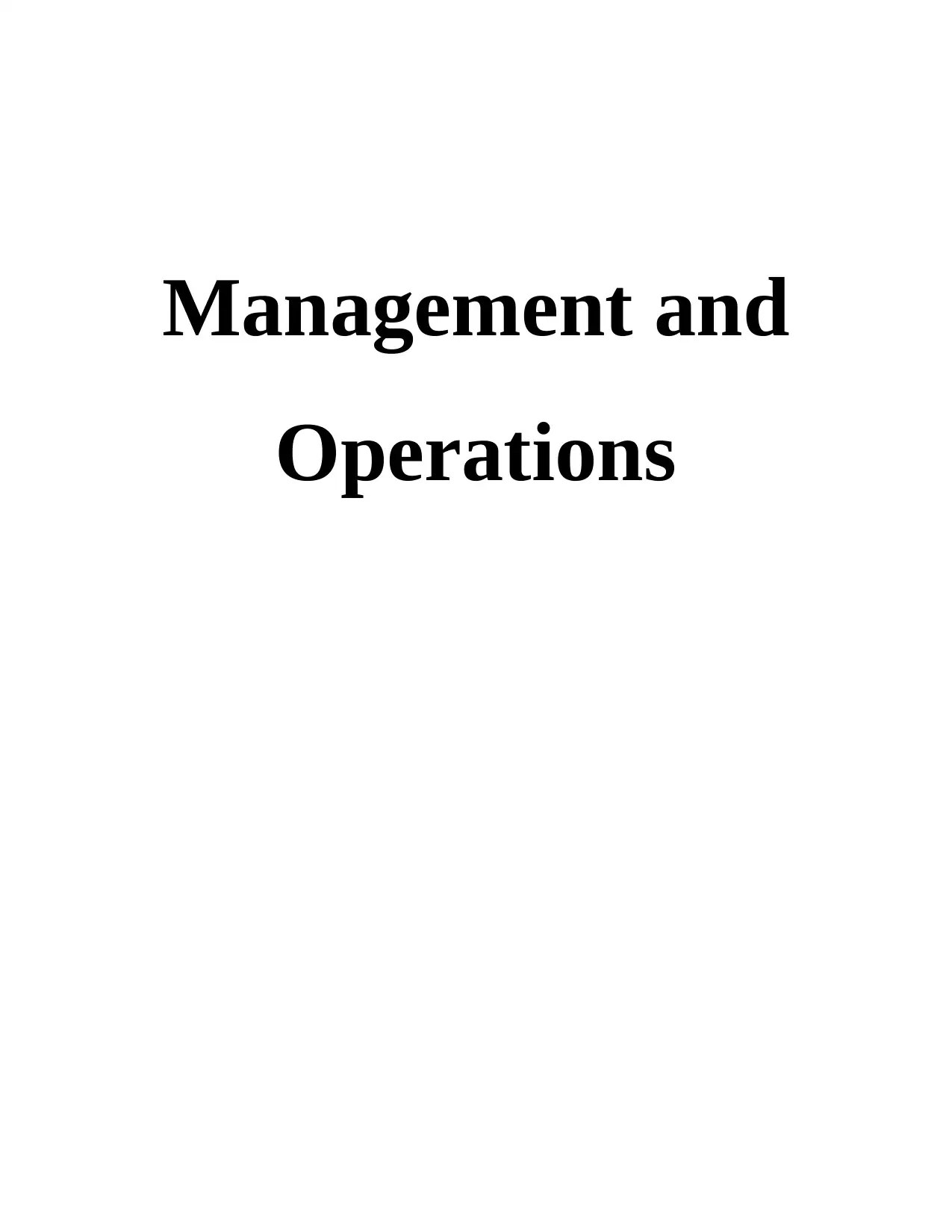
Management and
Operations
Operations
Paraphrase This Document
Need a fresh take? Get an instant paraphrase of this document with our AI Paraphraser
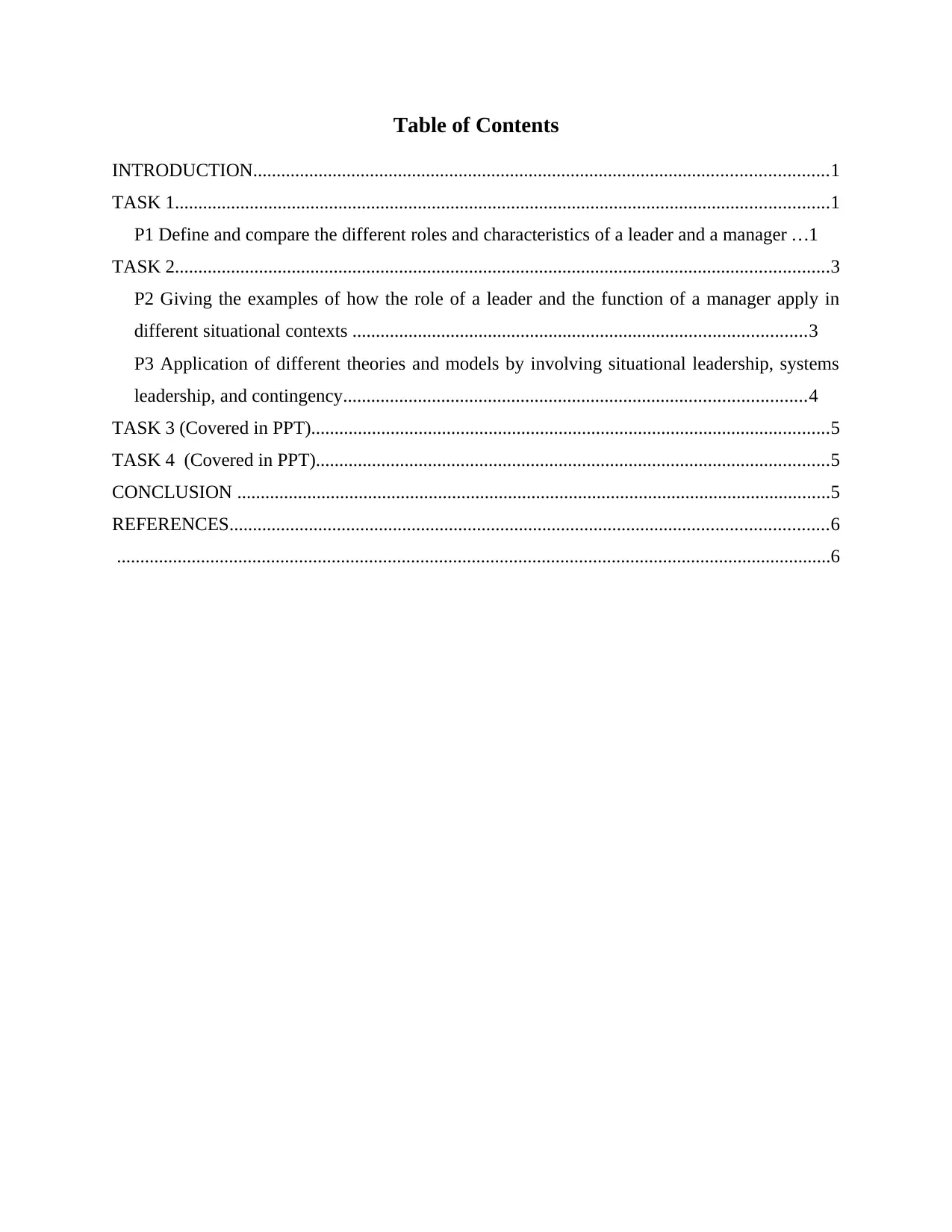
Table of Contents
INTRODUCTION...........................................................................................................................1
TASK 1............................................................................................................................................1
P1 Define and compare the different roles and characteristics of a leader and a manager ...1
TASK 2............................................................................................................................................3
P2 Giving the examples of how the role of a leader and the function of a manager apply in
different situational contexts .................................................................................................3
P3 Application of different theories and models by involving situational leadership, systems
leadership, and contingency...................................................................................................4
TASK 3 (Covered in PPT)...............................................................................................................5
TASK 4 (Covered in PPT)..............................................................................................................5
CONCLUSION ...............................................................................................................................5
REFERENCES................................................................................................................................6
.........................................................................................................................................................6
INTRODUCTION...........................................................................................................................1
TASK 1............................................................................................................................................1
P1 Define and compare the different roles and characteristics of a leader and a manager ...1
TASK 2............................................................................................................................................3
P2 Giving the examples of how the role of a leader and the function of a manager apply in
different situational contexts .................................................................................................3
P3 Application of different theories and models by involving situational leadership, systems
leadership, and contingency...................................................................................................4
TASK 3 (Covered in PPT)...............................................................................................................5
TASK 4 (Covered in PPT)..............................................................................................................5
CONCLUSION ...............................................................................................................................5
REFERENCES................................................................................................................................6
.........................................................................................................................................................6

⊘ This is a preview!⊘
Do you want full access?
Subscribe today to unlock all pages.

Trusted by 1+ million students worldwide
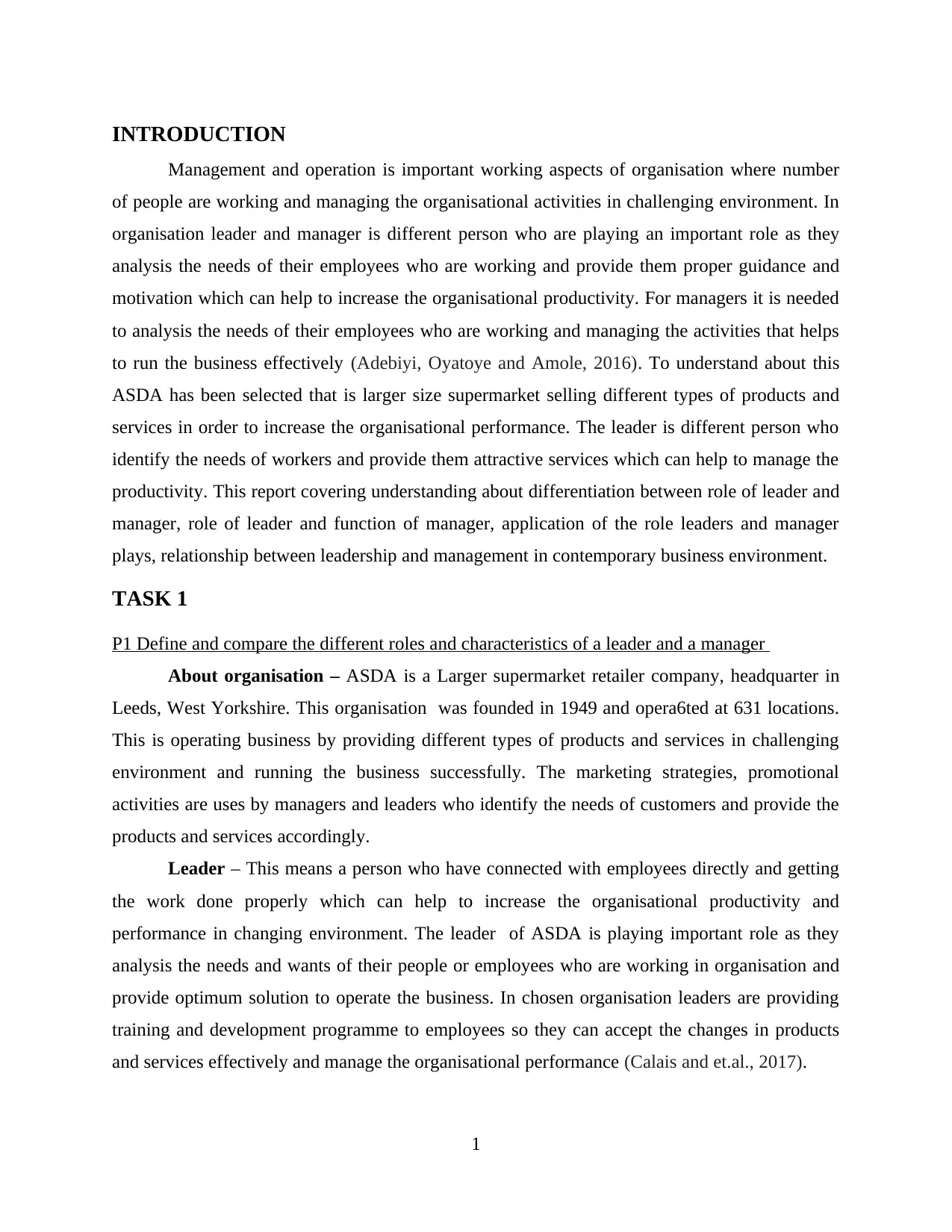
INTRODUCTION
Management and operation is important working aspects of organisation where number
of people are working and managing the organisational activities in challenging environment. In
organisation leader and manager is different person who are playing an important role as they
analysis the needs of their employees who are working and provide them proper guidance and
motivation which can help to increase the organisational productivity. For managers it is needed
to analysis the needs of their employees who are working and managing the activities that helps
to run the business effectively (Adebiyi, Oyatoye and Amole, 2016). To understand about this
ASDA has been selected that is larger size supermarket selling different types of products and
services in order to increase the organisational performance. The leader is different person who
identify the needs of workers and provide them attractive services which can help to manage the
productivity. This report covering understanding about differentiation between role of leader and
manager, role of leader and function of manager, application of the role leaders and manager
plays, relationship between leadership and management in contemporary business environment.
TASK 1
P1 Define and compare the different roles and characteristics of a leader and a manager
About organisation – ASDA is a Larger supermarket retailer company, headquarter in
Leeds, West Yorkshire. This organisation was founded in 1949 and opera6ted at 631 locations.
This is operating business by providing different types of products and services in challenging
environment and running the business successfully. The marketing strategies, promotional
activities are uses by managers and leaders who identify the needs of customers and provide the
products and services accordingly.
Leader – This means a person who have connected with employees directly and getting
the work done properly which can help to increase the organisational productivity and
performance in changing environment. The leader of ASDA is playing important role as they
analysis the needs and wants of their people or employees who are working in organisation and
provide optimum solution to operate the business. In chosen organisation leaders are providing
training and development programme to employees so they can accept the changes in products
and services effectively and manage the organisational performance (Calais and et.al., 2017).
1
Management and operation is important working aspects of organisation where number
of people are working and managing the organisational activities in challenging environment. In
organisation leader and manager is different person who are playing an important role as they
analysis the needs of their employees who are working and provide them proper guidance and
motivation which can help to increase the organisational productivity. For managers it is needed
to analysis the needs of their employees who are working and managing the activities that helps
to run the business effectively (Adebiyi, Oyatoye and Amole, 2016). To understand about this
ASDA has been selected that is larger size supermarket selling different types of products and
services in order to increase the organisational performance. The leader is different person who
identify the needs of workers and provide them attractive services which can help to manage the
productivity. This report covering understanding about differentiation between role of leader and
manager, role of leader and function of manager, application of the role leaders and manager
plays, relationship between leadership and management in contemporary business environment.
TASK 1
P1 Define and compare the different roles and characteristics of a leader and a manager
About organisation – ASDA is a Larger supermarket retailer company, headquarter in
Leeds, West Yorkshire. This organisation was founded in 1949 and opera6ted at 631 locations.
This is operating business by providing different types of products and services in challenging
environment and running the business successfully. The marketing strategies, promotional
activities are uses by managers and leaders who identify the needs of customers and provide the
products and services accordingly.
Leader – This means a person who have connected with employees directly and getting
the work done properly which can help to increase the organisational productivity and
performance in changing environment. The leader of ASDA is playing important role as they
analysis the needs and wants of their people or employees who are working in organisation and
provide optimum solution to operate the business. In chosen organisation leaders are providing
training and development programme to employees so they can accept the changes in products
and services effectively and manage the organisational performance (Calais and et.al., 2017).
1
Paraphrase This Document
Need a fresh take? Get an instant paraphrase of this document with our AI Paraphraser
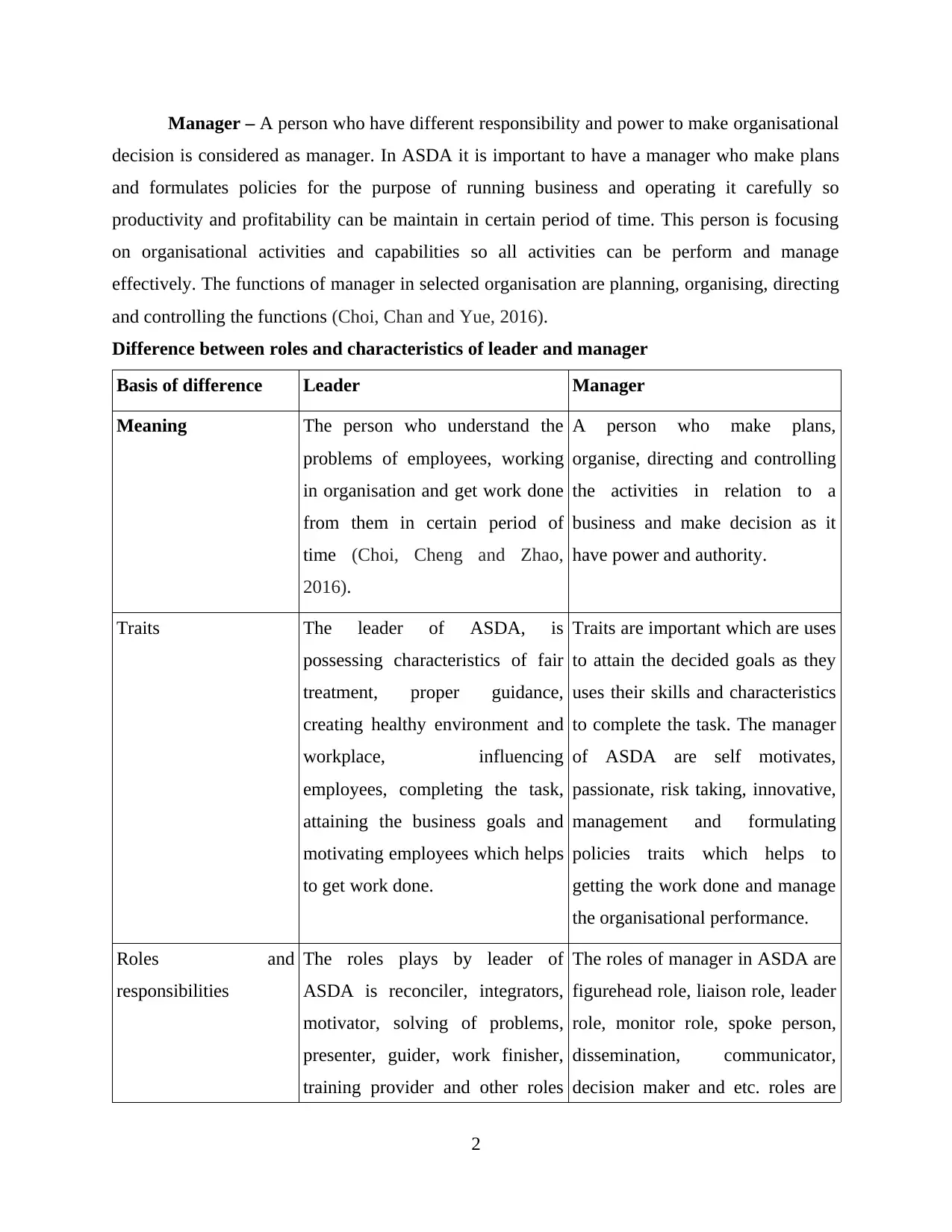
Manager – A person who have different responsibility and power to make organisational
decision is considered as manager. In ASDA it is important to have a manager who make plans
and formulates policies for the purpose of running business and operating it carefully so
productivity and profitability can be maintain in certain period of time. This person is focusing
on organisational activities and capabilities so all activities can be perform and manage
effectively. The functions of manager in selected organisation are planning, organising, directing
and controlling the functions (Choi, Chan and Yue, 2016).
Difference between roles and characteristics of leader and manager
Basis of difference Leader Manager
Meaning The person who understand the
problems of employees, working
in organisation and get work done
from them in certain period of
time (Choi, Cheng and Zhao,
2016).
A person who make plans,
organise, directing and controlling
the activities in relation to a
business and make decision as it
have power and authority.
Traits The leader of ASDA, is
possessing characteristics of fair
treatment, proper guidance,
creating healthy environment and
workplace, influencing
employees, completing the task,
attaining the business goals and
motivating employees which helps
to get work done.
Traits are important which are uses
to attain the decided goals as they
uses their skills and characteristics
to complete the task. The manager
of ASDA are self motivates,
passionate, risk taking, innovative,
management and formulating
policies traits which helps to
getting the work done and manage
the organisational performance.
Roles and
responsibilities
The roles plays by leader of
ASDA is reconciler, integrators,
motivator, solving of problems,
presenter, guider, work finisher,
training provider and other roles
The roles of manager in ASDA are
figurehead role, liaison role, leader
role, monitor role, spoke person,
dissemination, communicator,
decision maker and etc. roles are
2
decision is considered as manager. In ASDA it is important to have a manager who make plans
and formulates policies for the purpose of running business and operating it carefully so
productivity and profitability can be maintain in certain period of time. This person is focusing
on organisational activities and capabilities so all activities can be perform and manage
effectively. The functions of manager in selected organisation are planning, organising, directing
and controlling the functions (Choi, Chan and Yue, 2016).
Difference between roles and characteristics of leader and manager
Basis of difference Leader Manager
Meaning The person who understand the
problems of employees, working
in organisation and get work done
from them in certain period of
time (Choi, Cheng and Zhao,
2016).
A person who make plans,
organise, directing and controlling
the activities in relation to a
business and make decision as it
have power and authority.
Traits The leader of ASDA, is
possessing characteristics of fair
treatment, proper guidance,
creating healthy environment and
workplace, influencing
employees, completing the task,
attaining the business goals and
motivating employees which helps
to get work done.
Traits are important which are uses
to attain the decided goals as they
uses their skills and characteristics
to complete the task. The manager
of ASDA are self motivates,
passionate, risk taking, innovative,
management and formulating
policies traits which helps to
getting the work done and manage
the organisational performance.
Roles and
responsibilities
The roles plays by leader of
ASDA is reconciler, integrators,
motivator, solving of problems,
presenter, guider, work finisher,
training provider and other roles
The roles of manager in ASDA are
figurehead role, liaison role, leader
role, monitor role, spoke person,
dissemination, communicator,
decision maker and etc. roles are
2
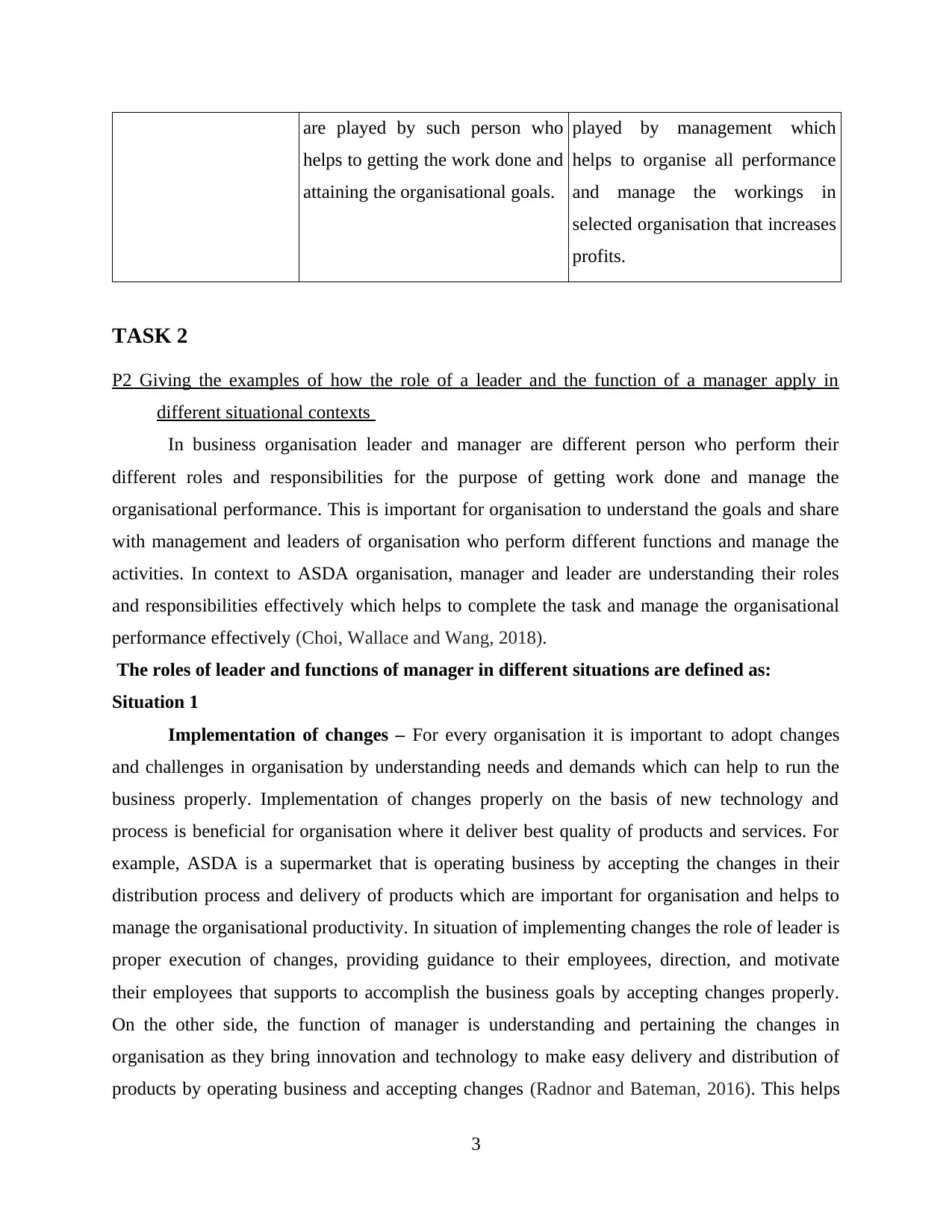
are played by such person who
helps to getting the work done and
attaining the organisational goals.
played by management which
helps to organise all performance
and manage the workings in
selected organisation that increases
profits.
TASK 2
P2 Giving the examples of how the role of a leader and the function of a manager apply in
different situational contexts
In business organisation leader and manager are different person who perform their
different roles and responsibilities for the purpose of getting work done and manage the
organisational performance. This is important for organisation to understand the goals and share
with management and leaders of organisation who perform different functions and manage the
activities. In context to ASDA organisation, manager and leader are understanding their roles
and responsibilities effectively which helps to complete the task and manage the organisational
performance effectively (Choi, Wallace and Wang, 2018).
The roles of leader and functions of manager in different situations are defined as:
Situation 1
Implementation of changes – For every organisation it is important to adopt changes
and challenges in organisation by understanding needs and demands which can help to run the
business properly. Implementation of changes properly on the basis of new technology and
process is beneficial for organisation where it deliver best quality of products and services. For
example, ASDA is a supermarket that is operating business by accepting the changes in their
distribution process and delivery of products which are important for organisation and helps to
manage the organisational productivity. In situation of implementing changes the role of leader is
proper execution of changes, providing guidance to their employees, direction, and motivate
their employees that supports to accomplish the business goals by accepting changes properly.
On the other side, the function of manager is understanding and pertaining the changes in
organisation as they bring innovation and technology to make easy delivery and distribution of
products by operating business and accepting changes (Radnor and Bateman, 2016). This helps
3
helps to getting the work done and
attaining the organisational goals.
played by management which
helps to organise all performance
and manage the workings in
selected organisation that increases
profits.
TASK 2
P2 Giving the examples of how the role of a leader and the function of a manager apply in
different situational contexts
In business organisation leader and manager are different person who perform their
different roles and responsibilities for the purpose of getting work done and manage the
organisational performance. This is important for organisation to understand the goals and share
with management and leaders of organisation who perform different functions and manage the
activities. In context to ASDA organisation, manager and leader are understanding their roles
and responsibilities effectively which helps to complete the task and manage the organisational
performance effectively (Choi, Wallace and Wang, 2018).
The roles of leader and functions of manager in different situations are defined as:
Situation 1
Implementation of changes – For every organisation it is important to adopt changes
and challenges in organisation by understanding needs and demands which can help to run the
business properly. Implementation of changes properly on the basis of new technology and
process is beneficial for organisation where it deliver best quality of products and services. For
example, ASDA is a supermarket that is operating business by accepting the changes in their
distribution process and delivery of products which are important for organisation and helps to
manage the organisational productivity. In situation of implementing changes the role of leader is
proper execution of changes, providing guidance to their employees, direction, and motivate
their employees that supports to accomplish the business goals by accepting changes properly.
On the other side, the function of manager is understanding and pertaining the changes in
organisation as they bring innovation and technology to make easy delivery and distribution of
products by operating business and accepting changes (Radnor and Bateman, 2016). This helps
3
⊘ This is a preview!⊘
Do you want full access?
Subscribe today to unlock all pages.

Trusted by 1+ million students worldwide
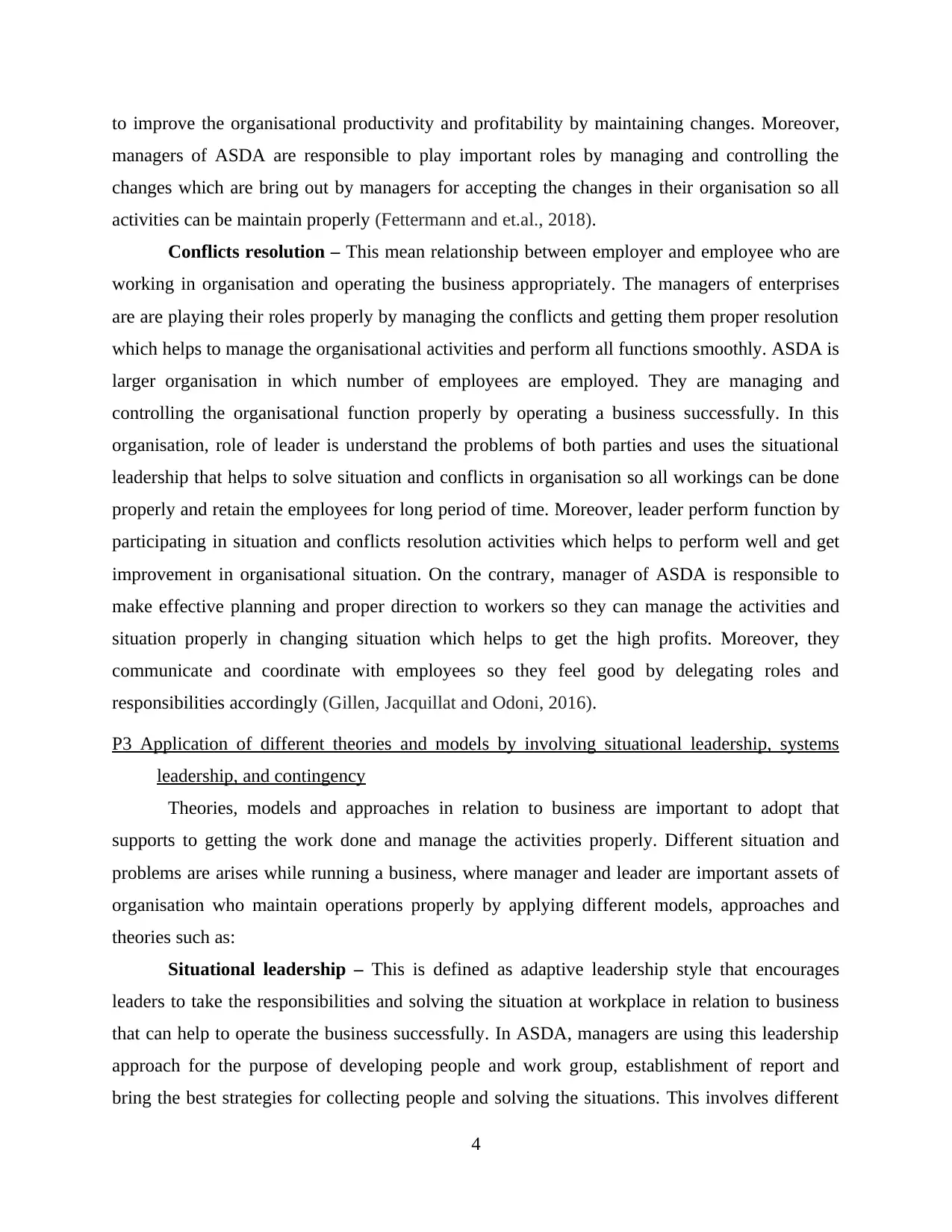
to improve the organisational productivity and profitability by maintaining changes. Moreover,
managers of ASDA are responsible to play important roles by managing and controlling the
changes which are bring out by managers for accepting the changes in their organisation so all
activities can be maintain properly (Fettermann and et.al., 2018).
Conflicts resolution – This mean relationship between employer and employee who are
working in organisation and operating the business appropriately. The managers of enterprises
are are playing their roles properly by managing the conflicts and getting them proper resolution
which helps to manage the organisational activities and perform all functions smoothly. ASDA is
larger organisation in which number of employees are employed. They are managing and
controlling the organisational function properly by operating a business successfully. In this
organisation, role of leader is understand the problems of both parties and uses the situational
leadership that helps to solve situation and conflicts in organisation so all workings can be done
properly and retain the employees for long period of time. Moreover, leader perform function by
participating in situation and conflicts resolution activities which helps to perform well and get
improvement in organisational situation. On the contrary, manager of ASDA is responsible to
make effective planning and proper direction to workers so they can manage the activities and
situation properly in changing situation which helps to get the high profits. Moreover, they
communicate and coordinate with employees so they feel good by delegating roles and
responsibilities accordingly (Gillen, Jacquillat and Odoni, 2016).
P3 Application of different theories and models by involving situational leadership, systems
leadership, and contingency
Theories, models and approaches in relation to business are important to adopt that
supports to getting the work done and manage the activities properly. Different situation and
problems are arises while running a business, where manager and leader are important assets of
organisation who maintain operations properly by applying different models, approaches and
theories such as:
Situational leadership – This is defined as adaptive leadership style that encourages
leaders to take the responsibilities and solving the situation at workplace in relation to business
that can help to operate the business successfully. In ASDA, managers are using this leadership
approach for the purpose of developing people and work group, establishment of report and
bring the best strategies for collecting people and solving the situations. This involves different
4
managers of ASDA are responsible to play important roles by managing and controlling the
changes which are bring out by managers for accepting the changes in their organisation so all
activities can be maintain properly (Fettermann and et.al., 2018).
Conflicts resolution – This mean relationship between employer and employee who are
working in organisation and operating the business appropriately. The managers of enterprises
are are playing their roles properly by managing the conflicts and getting them proper resolution
which helps to manage the organisational activities and perform all functions smoothly. ASDA is
larger organisation in which number of employees are employed. They are managing and
controlling the organisational function properly by operating a business successfully. In this
organisation, role of leader is understand the problems of both parties and uses the situational
leadership that helps to solve situation and conflicts in organisation so all workings can be done
properly and retain the employees for long period of time. Moreover, leader perform function by
participating in situation and conflicts resolution activities which helps to perform well and get
improvement in organisational situation. On the contrary, manager of ASDA is responsible to
make effective planning and proper direction to workers so they can manage the activities and
situation properly in changing situation which helps to get the high profits. Moreover, they
communicate and coordinate with employees so they feel good by delegating roles and
responsibilities accordingly (Gillen, Jacquillat and Odoni, 2016).
P3 Application of different theories and models by involving situational leadership, systems
leadership, and contingency
Theories, models and approaches in relation to business are important to adopt that
supports to getting the work done and manage the activities properly. Different situation and
problems are arises while running a business, where manager and leader are important assets of
organisation who maintain operations properly by applying different models, approaches and
theories such as:
Situational leadership – This is defined as adaptive leadership style that encourages
leaders to take the responsibilities and solving the situation at workplace in relation to business
that can help to operate the business successfully. In ASDA, managers are using this leadership
approach for the purpose of developing people and work group, establishment of report and
bring the best strategies for collecting people and solving the situations. This involves different
4
Paraphrase This Document
Need a fresh take? Get an instant paraphrase of this document with our AI Paraphraser
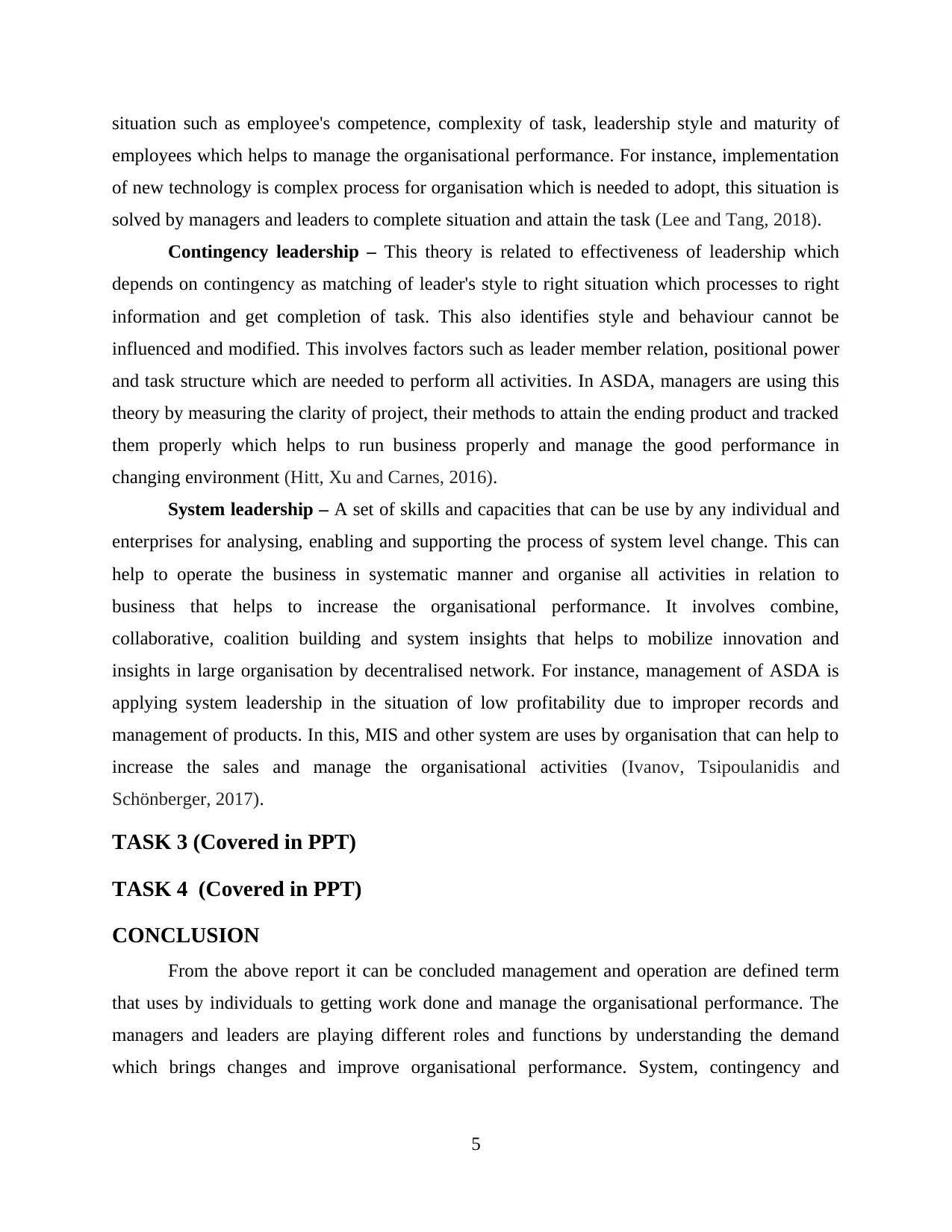
situation such as employee's competence, complexity of task, leadership style and maturity of
employees which helps to manage the organisational performance. For instance, implementation
of new technology is complex process for organisation which is needed to adopt, this situation is
solved by managers and leaders to complete situation and attain the task (Lee and Tang, 2018).
Contingency leadership – This theory is related to effectiveness of leadership which
depends on contingency as matching of leader's style to right situation which processes to right
information and get completion of task. This also identifies style and behaviour cannot be
influenced and modified. This involves factors such as leader member relation, positional power
and task structure which are needed to perform all activities. In ASDA, managers are using this
theory by measuring the clarity of project, their methods to attain the ending product and tracked
them properly which helps to run business properly and manage the good performance in
changing environment (Hitt, Xu and Carnes, 2016).
System leadership – A set of skills and capacities that can be use by any individual and
enterprises for analysing, enabling and supporting the process of system level change. This can
help to operate the business in systematic manner and organise all activities in relation to
business that helps to increase the organisational performance. It involves combine,
collaborative, coalition building and system insights that helps to mobilize innovation and
insights in large organisation by decentralised network. For instance, management of ASDA is
applying system leadership in the situation of low profitability due to improper records and
management of products. In this, MIS and other system are uses by organisation that can help to
increase the sales and manage the organisational activities (Ivanov, Tsipoulanidis and
Schönberger, 2017).
TASK 3 (Covered in PPT)
TASK 4 (Covered in PPT)
CONCLUSION
From the above report it can be concluded management and operation are defined term
that uses by individuals to getting work done and manage the organisational performance. The
managers and leaders are playing different roles and functions by understanding the demand
which brings changes and improve organisational performance. System, contingency and
5
employees which helps to manage the organisational performance. For instance, implementation
of new technology is complex process for organisation which is needed to adopt, this situation is
solved by managers and leaders to complete situation and attain the task (Lee and Tang, 2018).
Contingency leadership – This theory is related to effectiveness of leadership which
depends on contingency as matching of leader's style to right situation which processes to right
information and get completion of task. This also identifies style and behaviour cannot be
influenced and modified. This involves factors such as leader member relation, positional power
and task structure which are needed to perform all activities. In ASDA, managers are using this
theory by measuring the clarity of project, their methods to attain the ending product and tracked
them properly which helps to run business properly and manage the good performance in
changing environment (Hitt, Xu and Carnes, 2016).
System leadership – A set of skills and capacities that can be use by any individual and
enterprises for analysing, enabling and supporting the process of system level change. This can
help to operate the business in systematic manner and organise all activities in relation to
business that helps to increase the organisational performance. It involves combine,
collaborative, coalition building and system insights that helps to mobilize innovation and
insights in large organisation by decentralised network. For instance, management of ASDA is
applying system leadership in the situation of low profitability due to improper records and
management of products. In this, MIS and other system are uses by organisation that can help to
increase the sales and manage the organisational activities (Ivanov, Tsipoulanidis and
Schönberger, 2017).
TASK 3 (Covered in PPT)
TASK 4 (Covered in PPT)
CONCLUSION
From the above report it can be concluded management and operation are defined term
that uses by individuals to getting work done and manage the organisational performance. The
managers and leaders are playing different roles and functions by understanding the demand
which brings changes and improve organisational performance. System, contingency and
5
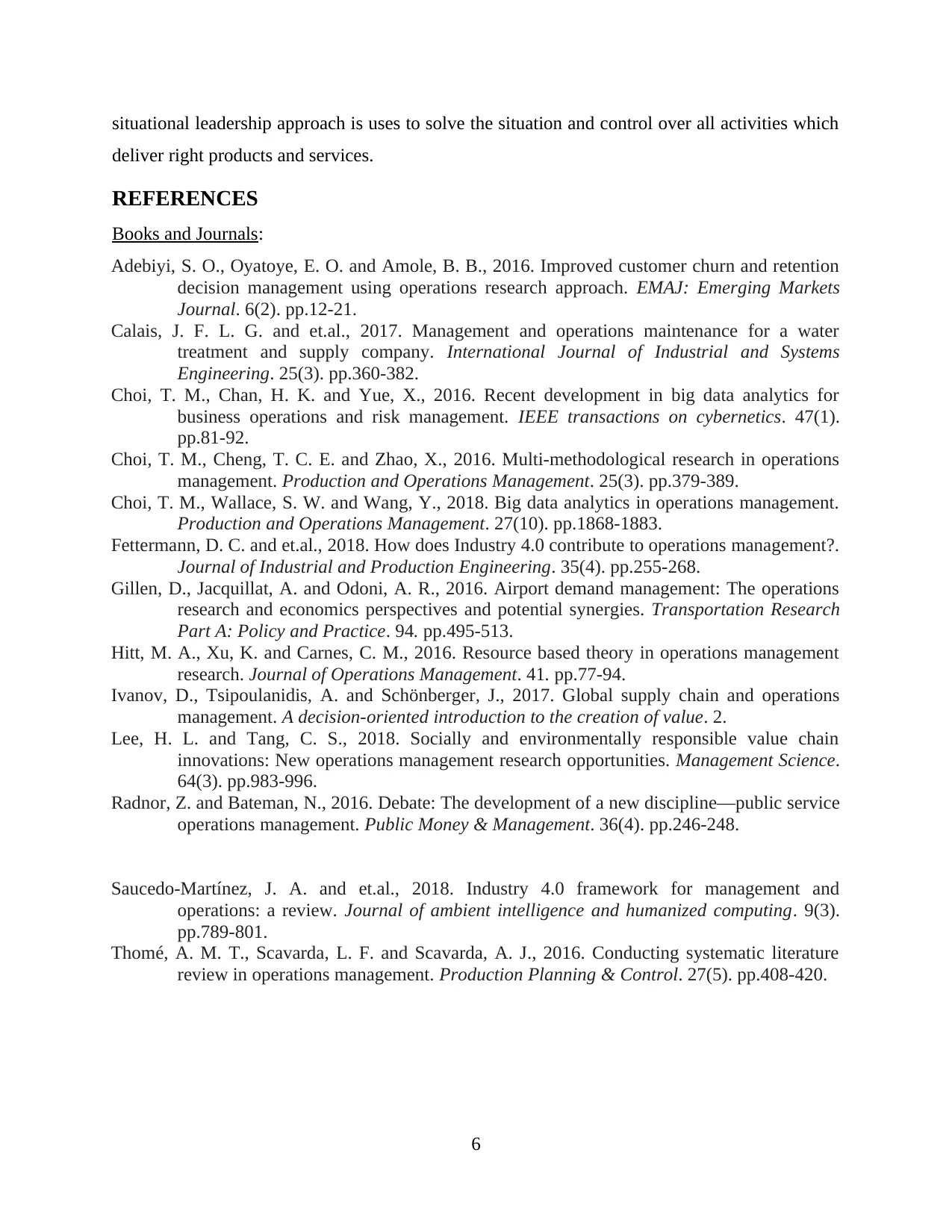
situational leadership approach is uses to solve the situation and control over all activities which
deliver right products and services.
REFERENCES
Books and Journals:
Adebiyi, S. O., Oyatoye, E. O. and Amole, B. B., 2016. Improved customer churn and retention
decision management using operations research approach. EMAJ: Emerging Markets
Journal. 6(2). pp.12-21.
Calais, J. F. L. G. and et.al., 2017. Management and operations maintenance for a water
treatment and supply company. International Journal of Industrial and Systems
Engineering. 25(3). pp.360-382.
Choi, T. M., Chan, H. K. and Yue, X., 2016. Recent development in big data analytics for
business operations and risk management. IEEE transactions on cybernetics. 47(1).
pp.81-92.
Choi, T. M., Cheng, T. C. E. and Zhao, X., 2016. Multi‐methodological research in operations
management. Production and Operations Management. 25(3). pp.379-389.
Choi, T. M., Wallace, S. W. and Wang, Y., 2018. Big data analytics in operations management.
Production and Operations Management. 27(10). pp.1868-1883.
Fettermann, D. C. and et.al., 2018. How does Industry 4.0 contribute to operations management?.
Journal of Industrial and Production Engineering. 35(4). pp.255-268.
Gillen, D., Jacquillat, A. and Odoni, A. R., 2016. Airport demand management: The operations
research and economics perspectives and potential synergies. Transportation Research
Part A: Policy and Practice. 94. pp.495-513.
Hitt, M. A., Xu, K. and Carnes, C. M., 2016. Resource based theory in operations management
research. Journal of Operations Management. 41. pp.77-94.
Ivanov, D., Tsipoulanidis, A. and Schönberger, J., 2017. Global supply chain and operations
management. A decision-oriented introduction to the creation of value. 2.
Lee, H. L. and Tang, C. S., 2018. Socially and environmentally responsible value chain
innovations: New operations management research opportunities. Management Science.
64(3). pp.983-996.
Radnor, Z. and Bateman, N., 2016. Debate: The development of a new discipline—public service
operations management. Public Money & Management. 36(4). pp.246-248.
Saucedo-Martínez, J. A. and et.al., 2018. Industry 4.0 framework for management and
operations: a review. Journal of ambient intelligence and humanized computing. 9(3).
pp.789-801.
Thomé, A. M. T., Scavarda, L. F. and Scavarda, A. J., 2016. Conducting systematic literature
review in operations management. Production Planning & Control. 27(5). pp.408-420.
6
deliver right products and services.
REFERENCES
Books and Journals:
Adebiyi, S. O., Oyatoye, E. O. and Amole, B. B., 2016. Improved customer churn and retention
decision management using operations research approach. EMAJ: Emerging Markets
Journal. 6(2). pp.12-21.
Calais, J. F. L. G. and et.al., 2017. Management and operations maintenance for a water
treatment and supply company. International Journal of Industrial and Systems
Engineering. 25(3). pp.360-382.
Choi, T. M., Chan, H. K. and Yue, X., 2016. Recent development in big data analytics for
business operations and risk management. IEEE transactions on cybernetics. 47(1).
pp.81-92.
Choi, T. M., Cheng, T. C. E. and Zhao, X., 2016. Multi‐methodological research in operations
management. Production and Operations Management. 25(3). pp.379-389.
Choi, T. M., Wallace, S. W. and Wang, Y., 2018. Big data analytics in operations management.
Production and Operations Management. 27(10). pp.1868-1883.
Fettermann, D. C. and et.al., 2018. How does Industry 4.0 contribute to operations management?.
Journal of Industrial and Production Engineering. 35(4). pp.255-268.
Gillen, D., Jacquillat, A. and Odoni, A. R., 2016. Airport demand management: The operations
research and economics perspectives and potential synergies. Transportation Research
Part A: Policy and Practice. 94. pp.495-513.
Hitt, M. A., Xu, K. and Carnes, C. M., 2016. Resource based theory in operations management
research. Journal of Operations Management. 41. pp.77-94.
Ivanov, D., Tsipoulanidis, A. and Schönberger, J., 2017. Global supply chain and operations
management. A decision-oriented introduction to the creation of value. 2.
Lee, H. L. and Tang, C. S., 2018. Socially and environmentally responsible value chain
innovations: New operations management research opportunities. Management Science.
64(3). pp.983-996.
Radnor, Z. and Bateman, N., 2016. Debate: The development of a new discipline—public service
operations management. Public Money & Management. 36(4). pp.246-248.
Saucedo-Martínez, J. A. and et.al., 2018. Industry 4.0 framework for management and
operations: a review. Journal of ambient intelligence and humanized computing. 9(3).
pp.789-801.
Thomé, A. M. T., Scavarda, L. F. and Scavarda, A. J., 2016. Conducting systematic literature
review in operations management. Production Planning & Control. 27(5). pp.408-420.
6
⊘ This is a preview!⊘
Do you want full access?
Subscribe today to unlock all pages.

Trusted by 1+ million students worldwide
1 out of 9
Related Documents
Your All-in-One AI-Powered Toolkit for Academic Success.
+13062052269
info@desklib.com
Available 24*7 on WhatsApp / Email
![[object Object]](/_next/static/media/star-bottom.7253800d.svg)
Unlock your academic potential
Copyright © 2020–2025 A2Z Services. All Rights Reserved. Developed and managed by ZUCOL.





